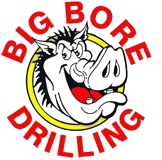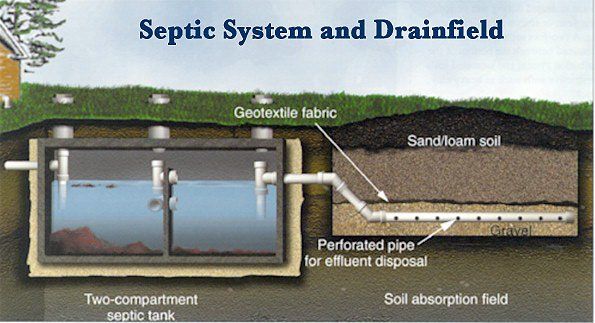Septic System Information IN FRESNO, CA
ALSO SERVING: SANGER, REEDLEY, MADERA, EASTON, HUNTINGtON LAKE & SURROUNDING AREAS
SEPTIC SYSTEM INFO
A septic system is a highly efficient, self-contained, underground waste water treatment system. Because septic systems treat and dispose of household waste water onsite, they are often more economical than centralized sewer systems in rural areas where lot sizes are larger and houses are spaced widely apart. Septic systems are also simple in design, which make them generally less expensive to install and maintain. And by using natural processes to treat the waste water onsite, septic systems don’t require the installation of miles of sewer lines, making them less disruptive to the environment.
If you are like most homeowners, you probably never give much thought to what happens when waste goes down your drain. But if you rely on a septic system to treat and dispose of your household waste water, what you don’t know can hurt you. Proper operation and maintenance of your septic system can have a significant impact on how well it works and how long it lasts.
Image Source: Produced by Agricultural Communications, The Texas A&M University System, EPA
A septic system consists of two main parts-a septic tank and a drain field. The septic tank is a watertight box, usually made of concrete, with an inlet and outlet pipe. Waste water flows from the home to the septic tank through the sewer pipe. The septic tank treats the waste water naturally by holding it in the tank long enough for solids and liquids to separate. The waste water forms three layers inside the tank. Solids lighter than water (such as greases and oils) float to the top forming a layer of scum. Solids heavier than water settle at the bottom of the tank forming a layer of sludge. This leaves a middle layer of partially clarified waste water.
Do’s and Don’ts
What Not To Flush
Homeowners wanting to take good care of their septic systems should make note of the following items that should never be flushed down the drain or toilet. These items can overtax or destroy the biological digestion taking place within the system or clog pumps and pipes.
Take care not to flush the following:
- hair combings, coffee grounds, dental floss, disposable diapers, or kitty litter,
- sanitary napkins, tampons, cigarette butts, or condoms,
- gauze bandages, fat, grease, or oil, paper towels,
And NEVER flush chemicals that could contaminate surface and groundwater, such as:
- paints, varnishes, thinners, waste oils, photographic solutions, or pesticides.
Modern Applications That May Affect Your Septic Systems
Garbage Disposals
Garbage disposals can increase the amount of solids in the tank up to 50 percent and should not be used. Eliminating a garbage disposal can greatly reduce the amount of grease and solids that enter the drainfield.
Many states require a larger minimum size septic tank if there will be a garbage grinder/disposal unit in operation in the house.
Water Softeners
Some freshwater purification systems, including water softeners, needlessly pump hundreds of gallons of water into the septic system all at once. This can agitate the solids and allow excess to flow into the drainfield. Consult a plumbing professional about alternative routing for such freshwater treatment systems.
How To Protect Your Septic System
Septic System Maintenance
If you own a septic system, it is important that it be properly maintained. How often you need to pump the solids out of your septic tank depends on three major factors:
1. The number of people in your household;
2. The amount of waste water generated (based on the number of people in the household and the amount of water used); and,
3. The volume of solids in the waste water (e.g., using a garbage disposal will increase the amount of solids).
Although your septic tank absorption field generally does not require maintenance, you should adhere to the following rules to protect and prolong its functional life:
- Do not drive over the absorption field with cars, trucks, or heavy equipment.
- Do not plant trees or shrubbery in the absorption field area, because the roots can get into the lines and plug them.
- Do not cover the absorption field with hard surfaces, such as concrete or asphalt. Grass is the best cover, because it will help prevent erosion and help remove excess water.
- Do divert surface runoff water from roofs, patios, driveways, and other areas away from the absorption field.
Septic system maintenance is often compared to automobile maintenance because only a little effort on a regular basis can save a lot of money and significantly prolong the life of the system.
Annual inspections of your septic system are recommended to ensure that it is working properly and to determine when the septic tank should be pumped. Systems that have moving parts may require more frequent inspections. By having your system inspected and pumped regularly, you can prevent the high cost of septic system failure.
When it’s time to pump, be sure to hire a licensed contractor. He or she will have the appropriate equipment and will dispose of the sludge at an approved treatment site. Pumping your septic tank is probably the single most important thing that you can do for your septic system maintenance.
Record keeping
It is very important to keep a detailed record of all inspections, pumping, permits, repairs, and any other maintenance to your system along with a sketch of where your septic system is located. Having this information on hand for service visits can save you both time and money.
Learn the location of your septic system, and keep a diagram or sketch of it with your maintenance records.
Protect the tank and drain field
Protect your septic system from potential damage. Don’t plant anything but grass near your septic system roots from shrubs and trees can cause damage and don’t allow anyone to drive or operate heavy machinery over any part of the system. Also, don’t build anything over the drain field. Grass is the most appropriate cover for the drain field.
Landscaping Your Septic System
Landscaping near and around septic systems is of concern to many homeowners. One of the most important things to keep in mind is to avoid planting trees near the tank or the leech lines. Tree roots are one of the primary reasons septic systems fail. Future access to the septic tank is also an important thing to plan for which means not planting or setting objects directly over the septic tank lid. Grass is the best thing to plant over the top of a leech line because it helps remove water without clogging the lines with roots. Paving over leech lines prevents them from working properly and reduces their effectiveness.
Landscaping for a Mound System
A mound system is required if three feet of separation cannot be achieved with an in ground trench system. Mound systems are designed to maximize the absorption capacity of existing soil. Mound location, size, shape, construction procedures and maintenance of the mound all interact in determining how well the system will function. Placement of plants on and near the mound must be done with care to ensure a properly functioning septic system. Plants enhance the system by removing moisture and nutrients from the soil and providing cover to prevent erosion.
Why Maintain Your Septic System
There are three main reasons why septic system maintenance is so important. The first reason is money. Failing septic systems are expensive to repair or replace, and improper maintenance by homeowners is a common cause of early system failure. The minimal amount of preventative maintenance that septic systems require costs very little in comparison to the cost of a new system. For example, it can cost anywhere from $5,000 to $15,000 to repair a failing septic system, compared to $395-$495 every 3-5 years to have a septic system routinely pumped.
The second and most important reason to properly maintain your system is the health of your family, your community, and the environment. When septic systems fail, inadequately treated household waste water is released into the environment. Any contact with untreated human waste can pose a significant risk to public health. Untreated waste water from failing septic systems can contaminate nearby wells, groundwater, and drinking water sources.
A third reason to maintain your septic system is to maintain the economic health of your community. Failing septic systems can cause property values to decline. Sometimes building permits cannot be issued for these properties. Also, failing septic systems may contribute to the pollution of local rivers, lakes, and shoreline that your community uses for commercial or recreational activities.
How Your Septic System Works
There are two main parts to the basic septic system: the septic tank and the drain field.
Household waste water first flows into the septic tank where it should stay for at least a day. In the tank, heavy solids in the waste water settle to the bottom forming a layer of sludge, and grease and light solids float to the top forming a layer of scum.
The sludge and scum remain in the tank where naturally occurring bacteria work to break them down. The bacteria cannot completely break down all of the sludge and scum, however, and this is why septic tanks need to be pumped periodically.
The separated waste water in the middle layer of the tank is pushed out into the drain field as more waste water enters the septic tank from the house. If too much water is flushed into the septic tank in a short period of time,the waste water flows out of the tank before it has had time to separate. This can happen on days when water use is unusually high, or more often if the septic tank is too small for the needs of the household. Homeowners should stagger their laundry throughout the week and try to do no more than two wash loads per day.
When waste water leaves a septic tank too soon, solids can be carried with it to the drain field. Drain fields provide additional treatment for the waste water by allowing it to trickle from a series of perforated pipes, through a layer of gravel, and down through the soil. The soil acts as a natural filter and contains organisms that help treat the waste. Solids damage the drain field by clogging the small holes in the drain field pipes, and excess water strains the system unnecessarily.
Conventional septic systems are a very simple way to treat household waste water. They contain no moving parts and are easy to operate and maintain. Although homeowners must take a more active role in maintaining septic systems, once they learn how their systems work, it is easy for them to appreciate the importance of a few sound operation and maintenance practices.

